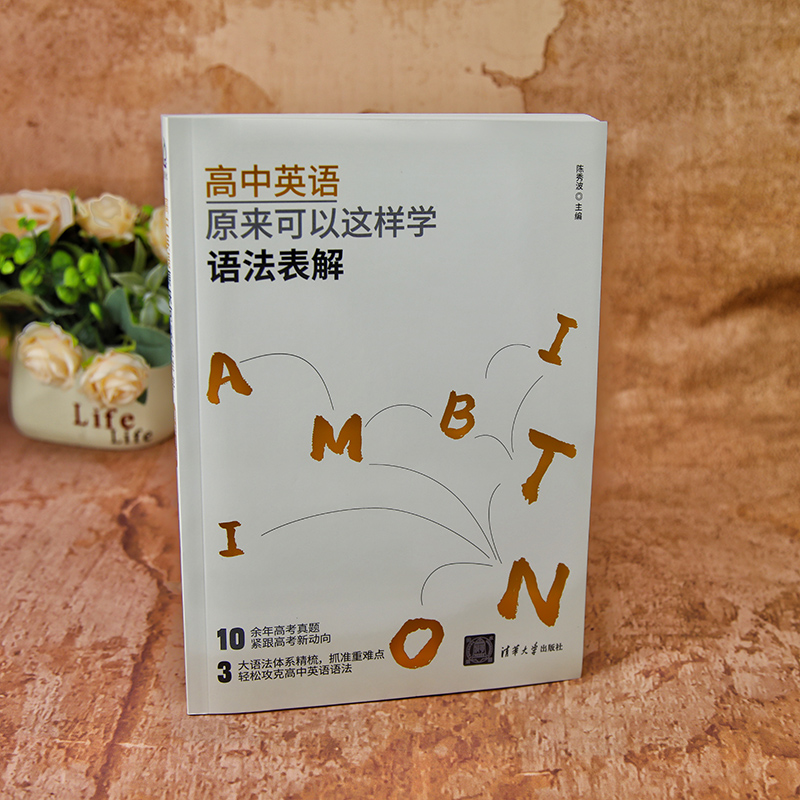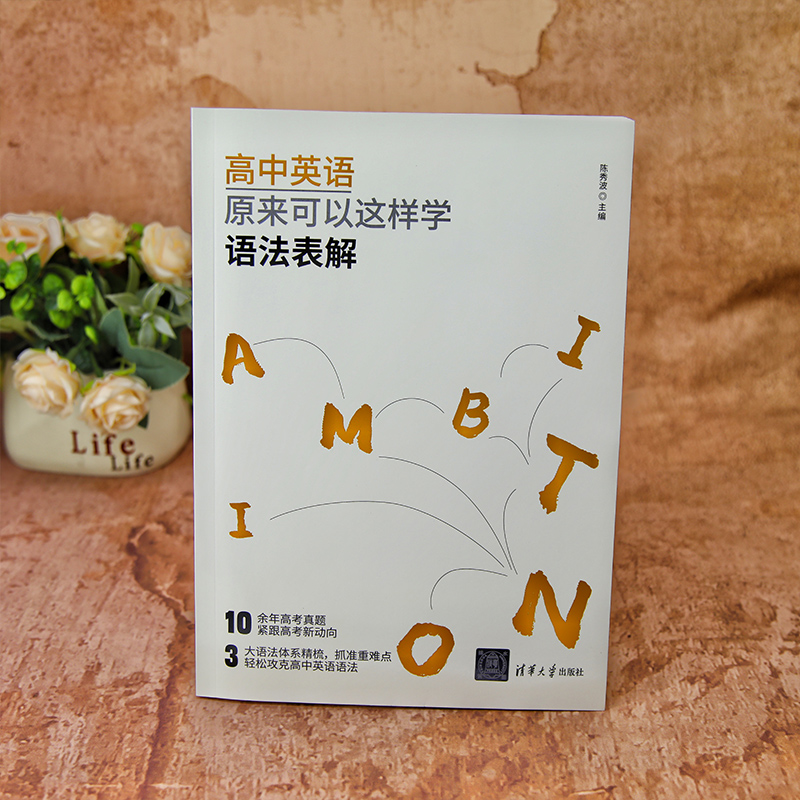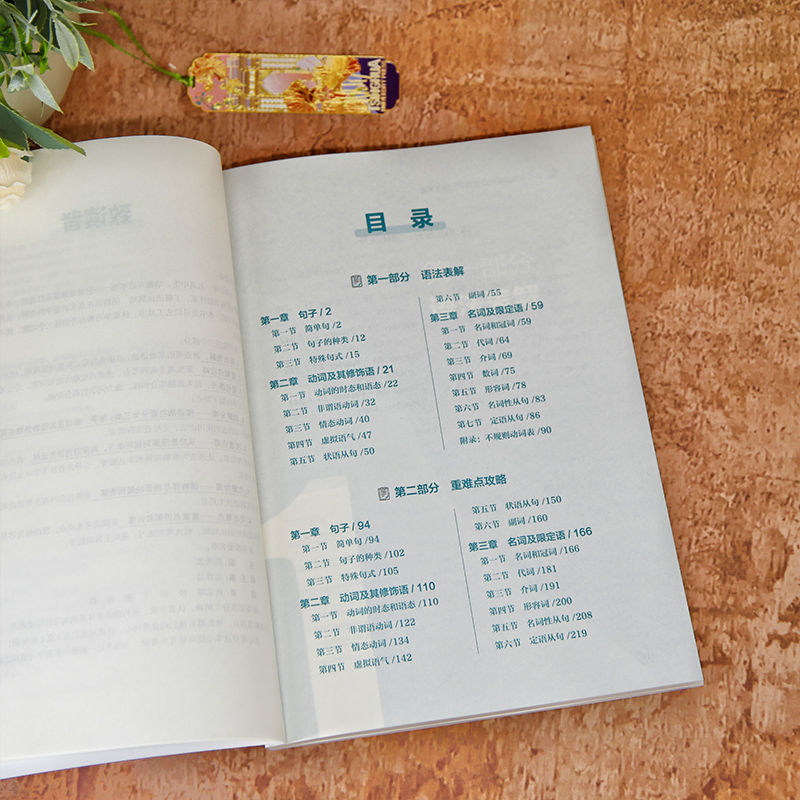精彩导读
第一部分 语法表解
59
第三章 名词及限定语
第一节名词和冠词
一、名词
名词的基本特征:
1.指代人、物、事、时间、地点、情感、概念等实体或抽象事物的词。
2.分为可数和不可数两大类。
3.常被冠词、介词、形容词、数词等修饰。
4.在句中常作主语、宾语、表语和定语。
表3-1 名词的分类及特点
分类
特点
例词
专有
名词
指人名、地
名、某类人
或事物专有
的名称
第一个字母通常大写
Tom, Beijing, the Great Wall,
Americans, Buddhism, Sunday,
June, New Year’s Day, Mum, A
Tale of Two Cities
普通
名词
个体
名词
可数
名词
可以指具体的人或物,也可指抽象的东
西。不能单独使用,需要被冠词、人称
代词或指示代词修饰,或用复数形式
book, house, apple, child, star,
panda, desk, year, century,
dream, story
集体
名词
视为整体时作单数看待,表示其成员
时当复数看待
class, group, family, police,
audience, data, family, army,
committee, crew, enemy, group,
public, herd, media, staff
物质
名词
不可
数
名词
无法被分为个体,不能被不定冠词
a(n)修饰;表达“一”的概念时,需要
借助量词。如:a piece of news
silver, water, air, cotton, rice,
equipment, furniture
抽象
名词
没有复数形式,前面一般不加不定冠
词a(n)
news, information, advice,
love, health, friendship, trade,
fun, silence, bravery
�
高中英语原来可以这样学:语法表解
60
表3-2 可数名词的复数形式
分类
变化规则
单数
复数
特例
规则
变化
一般情况,加-s,清辅
音后读/s/,浊辅音和元
音后读 /z/
map, bag
maps, bags
以s, sh, ch, x等结尾,
加-es,读 /iz/(以ce, se,
ze等结尾,加s,读/iz/)
bus, watch
buses,
watches
license
licenses
以“辅音字母+y”结尾,
变y为i, 再加es,读 /z/
(“以元音字母+y”结尾
的名词变复数时,直接
加s变复数)
baby
babies
monkey
monkeys
以“辅音字母+o”结尾
的名词后加-es
tomato, potato
tomatoes,
potatoes
radio → radios,zoo →
zoos,photo → photos
以f或fe 结尾的名词,
变f、fe为ves
knife
knives
roof → roofs, chief →
chiefs
不规则
变化
合成名词,将主体名词
变为复数
son-in-law, passer-
by, story-teller
sons-in-law,
passers-by,
story-tellers
当woman、man作定语
时,也要变成复数形式。
如:a woman teacher →
women teachers, a man
worker → men workers
特殊变化
child, foot, man,
woman,mouse
children,
feet, men,
women,
mice
单复同形
deer, sheep, fish,
Chinese, Japanese,
fruit
deer,
sheep, fish,
Chinese,
Japanese,
fruit
�
第一部分 语法表解
表3-3 名词的所有格
方式
例子
基本
方式
人或有生命的单数名词词尾加“’s”,
如果名词已有复数词尾s,就仅加“’”。
the boy’s bag, men’s room
the teachers’ office
“’s”也用于表示无生命的名词:
1)表时间;
2)表自然现象;
3)表国家、城市等地方;
4)表工作群体;
5)表度量及价值。
1) a day’s meeting; five weeks’ holiday
2) the moon’s rays; the tree’s branches
3) country’s plans; the world’s population
4) majority’s view; the team’s victory
5) 2 miles’ journey; twenty pounds’ weight
’s相关
用法
在表示店铺、教堂或某人的家里时,
只需要在名词后“’s”,不需要出现它
所修饰的名词。
the barber’s理发店,the tailor’s 裁缝店
’s相关
用法
两个名词并列,并且分别加’s,表示
“分别有”,只有一个’s,则表示“共有”。
John’s and Mary’s rooms 约翰的房间和玛
丽的房间
John and Mary’s room 约翰和玛丽的房间
of
表无生命的名词,在其前of 表达所有
关系“的”。
the roof of the house房顶
双重所
有格
用“名词+of+名词性物主代词”或“名
词+ of +名词所有格”表示。
1)of前的名词必须是一个不确指的
(如a/an,some,two等),表示特定
人的不特定的所有关系;
2)与指示代词this, that, these等、定
冠词the连用时,往往带有赞赏、厌恶、
不满等感情色彩,表达特殊情感。
one friend of mine = one of my friends’
1)a friend of George’s
some students of my teacher’s
2)The sweet eyes of Lily’s impressed me.
That old watch of my father’s gains a lot
every day.
辨析:
a friend of my father强调朋友关系
a friend of my father’s强调许多朋友
中的一个
Jim is a friend of my father.( Jim 是我父
亲的朋友。)
Jim is a friend of my father’s. (Jim是我父
亲的一个朋友。)
二、冠词
冠词的基本特征:
1. 不能单独使用,应置于名词之前,限定名词的意义。
2. 分为定冠词the和不定冠词an/ an, the用于表示“特指的(事物或人)”,a(n)用于
表示“泛指一个或一类”。
�
高中英语原来可以这样学:语法表解
表3-4 不定冠词a, an的用法
用法说明
举例
备注
基本
用法
a用在辅音前; an用在元音前。
泛指单一、每一、任一事物。
a boy, a useful book
an egg, an hour, an honest child
A man wants to see you.
判断元音和辅
音是指音标,
而不是字母
用来表示一类人或事物。
A Horse is very useful.
(= Horses are very useful. )
其他
用法
表示“每一”,相当于every,one。
We study eight hours a day.
用在序数词前,表示“又一、再一”
的含义。
When I sat down, a fourth man
stood up to speak.
固定
用法
so/ as/ too/ how + adj.+ a/ an +可数
名词单数。
such + a/ an + adj. + 可数名词单数
He is so great a man that everyone
loves him.
He is such a great man that
everyone loves him.
短语。
a great number of (+可数名词);
a great deal of(+不可数名词)
have a cold;have a fever;for
a while;in a word; have a word
with;at a loss
表3-5 定冠词the的用法
用法说明
举例
备注
基本
用法
特指某(些)人或某(些)事物。
所特指的名词常被短语或定语
从句所修饰
Is this the grammar book that you
are looking for?
指说话的双方都知道的人或
事物
Don’t worry if you can’t come to
the party. I’ll save some cake for
you.
复述上文中提到的事物,或者
与之相关的东西
There is a shelf in my father’s
room. The shelf is new.
其他
用法
用于单数可数名词之前,表示
该类事物
The computer has changed our
way of life.
发明创造物前
The bulb was invented by an
American.
表示世界上独一无二事物的名
词前
Do you know how big the universe
is?
�
第一部分 语法表解
用法说明
举例
备注
其他
用法
由普通名词构成的专有名词前
the United Nations
用在序数词、形容词最高级以
及形容词only, very, same前面
January is the first month of the
year.
He is the tallest boy in my class.
在姓氏复数前,表示一家人
The Smiths are having supper.
谓语动词用复数
用在年代、朝代名词前或用在
世纪或逢十的复数年代前
in the 1890s,
in the Ming Dynasty
用在表示计量单位的名词前
Apples are sold by the kilogram.
I am paid by the month.
但如果是单位名词
的总称,名词前不
用冠词,如:Fruit
is sold by weight.
用在表示乐器的名词前
play the piano
中国乐器前没有
定冠词,如:play
erhu
与形容词或分词连用,表示一
类人或者一类事物
These seats are for the disabled.
the rich, the young, the living
固定
用法
动词+ sb.+介词+ the +身体的
某一部位
take sb. by the arm
hit sb. on the head
短语
in the morning, all the year round,
at the same time
表3-6 零冠词的用法
用法说明
举例
备注
基本
用法
不可数名词、复数名词表示泛指
Water is important to us.
Horses are very useful.
专有名词前不加冠词
Asia, Europe
月、季节、星期、节假日、洲;
呼语、头衔、职务前;三餐、球
类,惯用语;学科、棋类名词前
May, spring, Monday, Christmas,
Africa, sir, chairman, breakfast,
football, physics, chess
表示特指时,应
用定冠词,如:
The winter of
last year was
extremely cold.
固定
用法
“零冠词+单数名词+ as/ though +
主语+谓语”表示“虽然/尽
管……,但是……”
Hero as he is, he has some
shortcomings.
续表
�
高中英语原来可以这样学:语法表解
用法说明
举例
备注
固定
用法
在独立主格结构中“名词+介词+
名词”
The teacher came in, book in
hand.
in +书写工具或者颜料
You can never write your
composition in red.
在“kind of +名词,sort of +名词”
句式中
What kind of flower is it?
turn, go作系动词,表示“变为、
成为”时,后接可数名词单数作
表语,不定冠词要省略
Has he turned scientist?
短语
out of work, in case of
第二节代词
代词的基本特征:
1. 是代替名词或名词短语的词。
2. 在句子中可以作主语、宾语、表语、同位语、定语。
3. 按其意义、特征及在句中的作用分为九类。
表3-7 代词的种类及用法
代词种类
代词
用法
例句
人称代词
主格
I, you, he, she, it,
we, you, they
作主语
She was carrying over
1500 passengers.
宾格
me, you, him, her,
it, us, you, them
作及物动词和介词的
宾语
Could you pass me that
book?
Let’s talk about it later.
物主代词
形容词性
my, your, his, her,
its, our, your, their
相当于形容词,后面
要接名词
James has sold his car.
名词性
mine, yours, his,
hers, its, ours,
yours, theirs
相当于名词,后面不
能接名词。名词性物
主代词 = 形容词性物
主代词+名词
You’ve got good legs —
mine are too thin.
续表
�
第一部分 语法表解
代词种类
代词
用法
例句
反身代词
myself, yourself, himself,
herself, itself, ourselves,
yourselves, themselves, oneself
作动词或介词的宾
语、表语、同位语
We kept ourselves awake
by playing card games.
相互代词
each other, one another
作宾语、定语
We always try to help
each other.
指示代词
this, that, these, those, it, such
作主、宾、表、定、
状语
The damage was such that
it would cost too much
money to repair.
疑问代词
who, whom, whose, which,
what
引导特殊疑问句,位
于句首
Which way is quicker by
bus or by train?
关系代词
who, whom, whose, which,
that, as
引导定语从句
I met a man with whom I
used to work.
不定代词
some, something, somebody,
someone, any, anything, anybody,
anyone, no, nhing, nobody,
no one, every, everything,
everybody, everyone, each,
much, many, little, a little, few,
a few, other, another, all, none,
one, both, either, neither
多数可以作主、宾、
表、定语,但none
和含有some, any, no,
every构成的合成代
词只能作主、宾、表
语,而every和no
只能作定语
Did anybody hurt himself?
There’s something sharp
in my shoe.
None of my children has/
have black hair.
Few people live to be 100.
Every child has a picture
on the desk.
连接代词
who, whom, whose, which,
what, that
引导主语从句、宾语
从句、表语从句
Show me what you bought.
表3-8 反身代词的用法
用法
例句
作动词的宾语
He devoted himself to the cause of education.
作介词的宾语
The children discussed the matter among themselves.
作表语
Jim hasn’t been himself for days.
作同位语
She herself admitted that it was wrong to believe him.
惯用语
与动词连用
意思
与介词连用
意思
absent oneself
缺席
among
yourselves
你们相互间
adapt oneself to sth.
适应于
between
ourselves
咱们私下
续表
�
高中英语原来可以这样学:语法表解
用法
例句
惯用语
与动词连用
意思
与介词连用
意思
apply oneself to sth.
专心致志于
beside
oneself
(由于激动或气氛)
发狂
behave oneself
使自己举止端正
by oneself
单独地,独自地
devote oneself to sth.
专心于;献身于
for oneself
为自己,替自己
dress oneself
自己穿衣服
in oneself
本身
enjoy oneself
玩得愉快
of oneself
自动地
find oneself…
发现自己在……
to oneself
独自用
help oneself to sth.
自取所需食物
hurt oneself
伤到自己
make oneself at
home
请随便,不要拘束
seat oneself
坐下
表3-9 it的用法
用法
例句
用作人称代词,代替前文提到的事
物、群体、想法、性别不明或性别
被认为不重要的人或动物、未指明
或谈话双方都明白的事
Where is my pen? I put it on the table.
You’ve saved my life. I shall never forget it.
— Who’s that? — It’s me.
表示时间、天气、距离等
It’s October 5th.
It’s a sunny day, isn’t it?
It’s 100 meters away from here.
用作形式主语或形式宾语,代替不
定式短语、动名词或从句
It’s important to master a foreign language.
It’s no good smoking.
I find it boring to read this book.
用在强调结构“It is/was+ 被强调成
分 + that/who…”,强调句子的某一
成分,通常是主语、宾语或状语。
It is professor Li that will give us a speech next Monday.
It wasn’t until last summer that I heard from him.
What is it that you want me to do?
用在不能直接跟宾语从句的动词
或短语后,尤其是表示好恶的动
词,如:enjoy, like, love, appreciate,
love, hate, be fond of, feel like, see
to,depend on等
I like it when she sings a song to me.
You needn’t go if you don’t feel like it.
续表
�
第一部分 语法表解
表3-10 many, much, few, a few, little, a little的区别
肯定
否定
例句
修饰可数
名词复数
many很多
few很少,
几乎没有
There are many spelling mistakes in this article.
Few people understand the difference.
a few几个,一些
I’ve seen most of his movies. Only a few are as
good as his first one.
修饰不可
数名词
much很多
little少许,
几乎没有
There isn’t much snow at this time of the year.
Little is known about his childhood.
a little一点儿
Could you give me a little water, please ?
表3-11 each, every的区别
用法
例句
each
强调个体,表示两个或两个以上中的每
一个
1)作形容词,修饰名词单数
2)作代词,可作主语、宾语或同位语
3)后可接of介词短语。
Trees have been planted on each side of the
river.
There are enough apples for the children.
Give them each.
I am going to ask each of you a question.
every
强调整体,表示三者或三者以上中的每
一个,只能作定语
We enjoyed every minute of our stay in
Beijing.
表3-12 all, both, either, neither, none, any的区别
区别
例句
两者
both都
Both of the girls are from Spain.
either任何一个
You can park your car on either side of the road.
neither都不
Neither of the books is interesting.
三者或三者以上
all都
All flowers are in bloom.
any 任何一个
Any person who breaks the law will be punished.
none 都不
He told me all the news but none of it was exciting.
�
高中英语原来可以这样学:语法表解
表3-13 none, nothing, no one/ nobody的区别
用法
例句
none
(三个以上)“没有任何(人、物)”,常用来
回答以How many/ How much…引起的疑问
句。后可接介词短语of…;作主语时,如果
代替的是可数名词,谓语动词既可用单数也
可以用复数;如果代替的是不可数名词,谓
语动词用单数
—Please give me some salt.
—Sorry, there is none left.
None of the children knew the
answer, which made me disappointed.
None of the students is/ are playing
in the gym.
nothing
“没什么,无事”
习惯句型:
nothing but除……以外什么也不,只不过是;
anything but除……外任何,根本不,绝不;
something of…出色的人物
Nothing can stop us from going
forward.
The fellow was said to be
something of a scholar. 据说这个
家伙是个出色的学者。
no one/
nobody
“没有一个人”,只能指人,是单数,常用来
否定回答Who引导的疑问句,后面不可接
of介词短语
—Who knocked the door?
— No one.
表3-14 it, one, the one, ones, the ones, that, those的区别
单数
用法
例句
复数
用法
例句
one
泛指,指代刚提到
的可数名词单数,
相当于a/an +单数
名词
I’d like a cup of coffee.
Are you having one?
ones
泛指,指代
刚提到的可
数名词复数
I’ve never seen such
beautiful flowers as
these ones.
the
one
特指,指代可数名
词单数
I want to buy a car like
the one on display.
the
ones
特指,指代
可数名词复
数,有时可
用those替
代(尤其在
有后置定语
的情况下)
The most successful
students I know are
usually the ones
who are extremely
diligent.
that
指代前面提到过的
单数可数名词或不
可数名词,特指,
相当于the +单数
名词/ 不可数名词
Life today is a lot better
than that in the old days.
The population of China
is larger than that of any
country in the world.
those
特指,指代
前面提到过
的复数名
词,以避免
重复
These pants are
more expensive
than those we saw
the other day.
it
指代上文提到的可
数或不可数名词
I like this watch and I
will take it.
�
第一部分 语法表解
第三节介词
介词的基本特征:
1. 用于名词、代词或相当于名词的结构之前,是表示词语之间意义关系的词。
2. 可以表达方位、时间、动向、原因、方式等。
3. 是虚词,不能单独作句子成分,必须与名词、代词构成介词短语。在句中充当一
个成分。
4. 介词短语在句中可以作定语、状语、表语、宾语和宾补。
表3-15 介词的分类
介词类型
例词
时间介词
at, in on, before, after, from
方位介词
on, in, at, behind, over, above, under, below
动向介词
to, into, up, down, through, along, out of
方式介词
by, on, with
原因介词
for, from, of, with
表3-16 常见时间介词的用法
in(指一般性
的某一时间)
1)表示在较长的时间里(周/月份/季节/年份/世纪等)。如:in a
week; in May; in spring; in 2008; in the 1990s等。
2)固定搭配。如:in the morning/afternoon/evening; in the daytime等。
3)“in+ 一段时间”表示“……以后/以内”,常与将来时连用。如:in
half an hour;in a few days; in a moment等。
I’ll be with you in a moment.
on(后面是具
体的某一天)
1)表示在具体的某一天(日期、生日、节日或星期几)。如:on May
4th,1919;on Monday;on Teachers’ Day;on my birthday;on the last day
of the month等。
2)表示某一天的上午、下午或晚上。如:on the morning of July 2;on
Sunday afternoon; on a cold winter evening等。
�



